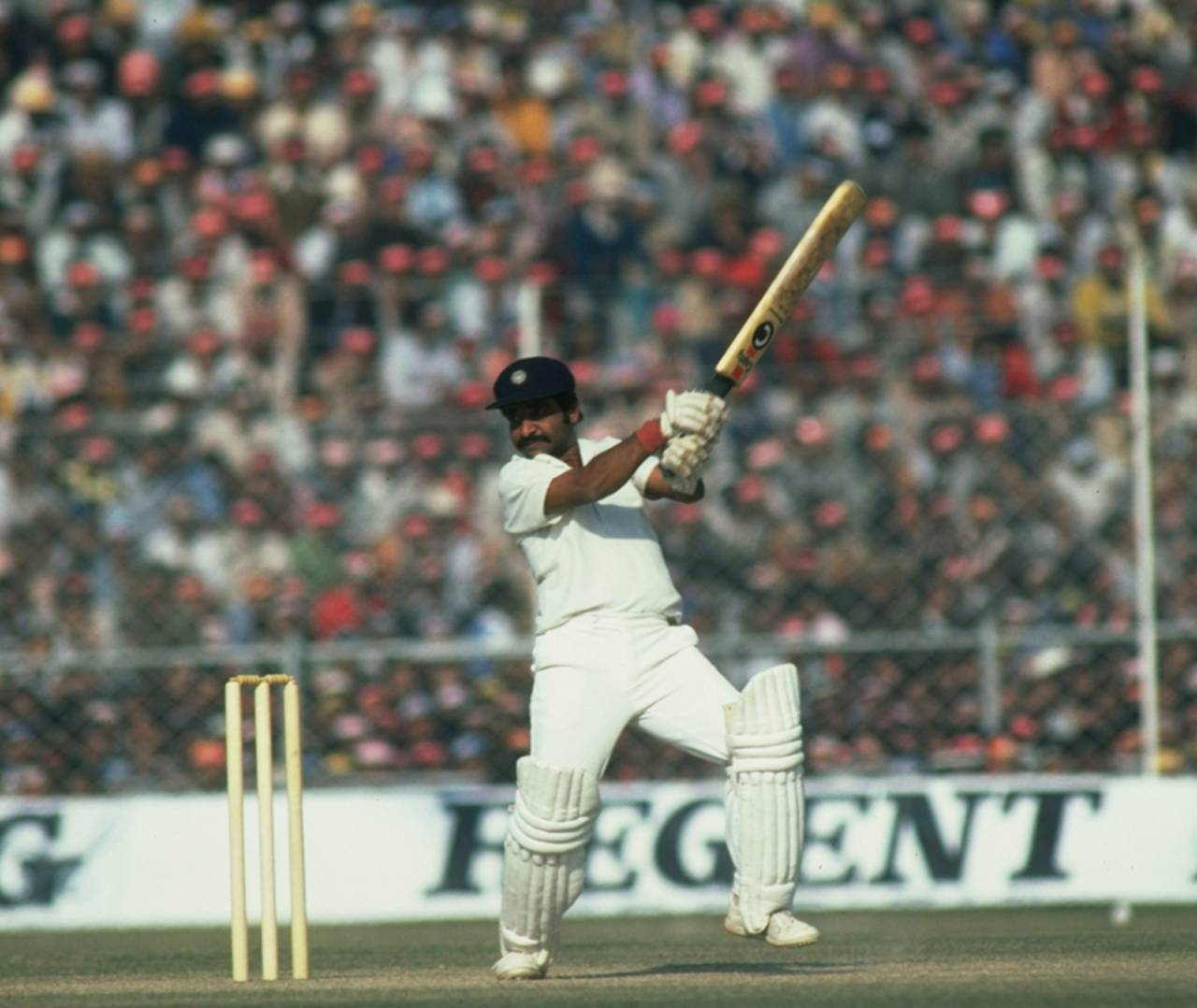A wizard called Vishy
Remembering a magician who invariably rose to the occasion when conditions favoured the bowlers, especially the fast men
V Ramnarayan
29-Jan-2014

Gundappa Viswanath played beside the ball rather than behind it on bouncy tracks • Getty Images
I had just finished reading a glowing reference to GR Viswanath in James Astill's recent book The Great Tamasha, by cricket journalist Haresh Pandya - lamenting the relative lack of recognition outside India of the little Karnataka bastman's greatness - when I serendipitously opened a cricket anthology by Andhra author Prasanna Kumar at a page devoted to describing GRV's double-century on his Ranji Trophy debut.
It struck me how similar my own - and I'm sure thousands of other Indians' - thinking on the subject had been, for I have always believed GRV belonged to the highest class of batsmen, though western writers have rarely accorded him the same status as they have other Indian greats, past and present.
I vividly remember the physical director of my college laughing at me after Vishy's first Test innings, in Kanpur in November 1969. "Your man scored a duck!" he cackled, because he knew I had been a diehard fan of the young batsman ever since I saw a couple of his brief but classy innings in the Duleep Trophy. Vishy had been the last of the rash of youngsters whom the chairman of selectors, Vijay Merchant, had blooded that season - at the insistence, I learnt, of the captain, MAK Pataudi.
"Wait for the second innings," I challenged Mr Subramaniam, who was a lovely man otherwise, very supportive of the college cricket team I was leading then. The rest was history, we all know. Viswanath hit 25 fours on his way to a delightful 137 against an Australian attack that included Graham McKenzie, Alan Connolly, Johnny Gleeson and Ashley Mallett. He was barely 20 then.
By the time I came face to face with Vishy as his State Bank of India team-mate in 1974, he had already scored his second Test hundred, at the Brabourne Stadium (the first Indian batsman to score another century after a debut hundred), against England, even though his contribution on the triumphant West Indies and England tours under Ajit Wadekar had been relatively modest. Not only was he a friendly senior in the team, he was also a gentle communicator with the rest of humanity, I discovered. He very politely requested a spectator who had strayed into the players' enclosure not to block his view. "Match nahin dekha to humko bahut dukh hota bhai [It makes me sad if I can't watch the match]!"
His brilliant 52 at Lord's that year was the forerunner of many splendid knocks against the touring West Indies that season. His 139 in Calcutta and 97 not out in Madras were quite the highlights of India's fightback against the marauding visitors. Though his Chepauk innings became the toast of the nation as he started farming the strike at 117 for 7 to take the total to 190 in the face of some fiery fast bowling by Andy Roberts (7 for 64), Vishy himself rated his Calcutta innings as by far his best Test knock until then.
A few years later, he was to play an even more courageous hand in India's hard-fought win against the same opponent, again at Chepauk, when on a nasty surface he made 124 and 31, taking several body blows from the hostile trio of Sylvester Clarke, Norbert Philip and Vanburn Holder. He had weathered the pace of Jeff Thomson to score consistently on the 1977-78 tour of Australia, and his 114 in Melbourne, against Dennis Lillee and Len Pascoe, was to prove decisive for India on the next tour of that country.
It was a characteristic of Viswanath's batting that he invariably rose to the occasion when conditions favoured the bowlers, especially the fast men. His double-hundred in Madras in January 1982 was scored on a wicket that offered pace and bounce on the first morning for the four-pronged attack of Bob Willis, Ian Botham, Graham Dilley and Paul Allott, before first Dilip Vengsarkar and later Vishy blunted the attack with an exciting counter-attack.
The little man was arguably the inventor of the technique of playing from beside the ball, rather than behind it, on bouncy tracks, and his square-cutting has scarcely been equalled. In domestic cricket he was known to be capable of playing at least two shots to any single delivery, perhaps three on occasion, as my Hyderabad team-mates and I sometimes discovered to our dismay. During one memorable gem he played in Bangalore, he kept playing outswingers with disdain past midwicket and mid-on, only to start forcing identical deliveries to point and the cover boundary once the three slips had moved one by one to the on side.
Viswanath rarely scored when his team did not need a contribution from him. He also found it difficult to concentrate against less-than-challenging bowling, as can be seen from his higher average in Test matches than in first-class cricket.
A lovely man with his own firm views on what constitutes fairplay in cricket, he never regretted his decision as captain to recall Bob Taylor after he was given out with England tottering at 58 for 5 in the Golden Jubilee Test in February 1980, a match India eventually lost. He has perhaps been the only Test cricketer to pull out of tour games at the eleventh hour to make way for young players in the reserves who he believed stood a chance of Test selection if they performed in those matches. South Zone's TE Srinivasan and V Sivaramakrishnan both got into the playing XI this way on different occasions.
Gundappa Viswanath was indeed a very special cricketer.
V Ramnarayan is an author, translator and teacher. He bowled offspin for Hyderabad and South Zone in the 1970s